Have you ever wondered what goes into the making of tequila? What are the secrets behind its unique flavor and the cultural significance it holds in Mexico? Join me on a journey as we explore the fascinating world of tequila agave plants and uncover the key ingredients and processes that make this iconic spirit so distinct.
Key Takeaways:
- Tequila is made from the piña, or heart, of the agave plant.
- The Blue Weber or Blue Agave variety is primarily used for tequila production.
- Tequila can only be made in designated areas in Mexico.
- Agave plants take several years to mature before they are harvested.
- The tequila distillation process involves various stages, including cooking, crushing, fermentation, and distillation.
Contents
- 1 Tequila vs. Mezcal: What’s the Difference?
- 2 Geography and Species Differences in Tequila Production
- 3 Mezcal: A Different Perspective on Agave Spirits
- 4 The Harvesting Process of Agave
- 5 The Cooking Process in Agave Spirit Production
- 6 Crushing and Extracting Agave Juice
- 7 Fermentation and Distillation of Agave Spirits
- 8 Aging Agave Spirits: From Blanco to Extra Añejo
- 9 The Global Icon: Tequila’s Rise to Fame
- 10 The Future of Agave and Tequila Production
- 11 Appreciating the Ancient Roots and Mythology of Tequila
- 12 FAQ
- 13 Source Links
Tequila vs. Mezcal: What’s the Difference?
Tequila and mezcal are both agave spirits that originate from Mexico. While they share similarities, there are distinct differences between the two. Understanding these differences can enhance your appreciation for these unique libations.
“Tequila and mezcal may both be agave spirits, but their production methods, geographical origins, and even the types of agave used set them apart.”
One of the key differences between tequila and mezcal lies in their production regions. Tequila can only be made in specific areas of Mexico, primarily in the state of Jalisco. Mezcal, on the other hand, can be produced in multiple states, including Oaxaca, Guerrero, and Durango.
Another distinguishing factor is the variety of agave used in their production. Tequila is primarily made from the Blue Weber agave, scientifically known as Agave tequilana Weber. Mezcal, however, can be crafted from various types of agave, resulting in a wider range of flavors and characteristics.
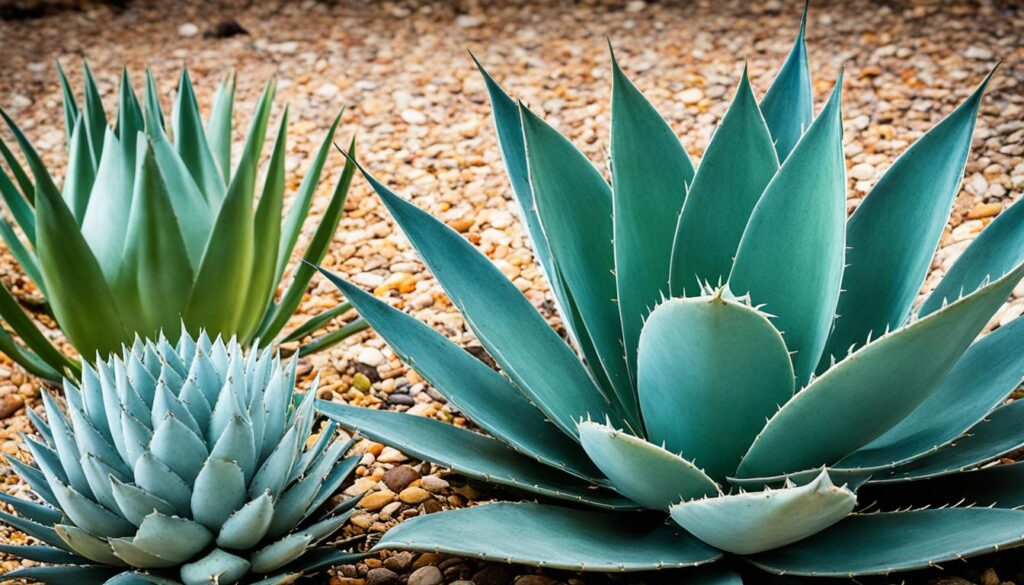
“Tequila is predominantly made from the Blue Weber agave, while mezcal showcases the diverse flavors of multiple agave species.”
The distinctions between tequila and mezcal extend to their production methods as well. Tequila is typically produced using modernized techniques that include industrial ovens for cooking the agave piñas (the heart of the agave plant). Mezcal, on the other hand, often employs traditional methods that utilize pit ovens or underground roasting to impart a distinct smoky flavor to the spirit.
Given these differences, it is important to note that not all mezcals are categorized as tequilas, but all tequilas can be considered mezcals. Tequila, with its specific production regulations and regional designation, has gained recognition as a global icon of Mexican culture. On the other hand, mezcal offers a diverse and artisanal perspective on agave spirits, showcasing unique flavors and historical traditions.
A Quick Comparison: Tequila vs. Mezcal
| Tequila | Mezcal |
|---|---|
| Region: Primarily Jalisco, Mexico | Region: Multiple states in Mexico |
| Agave: Blue Weber (Agave tequilana Weber) | Agave: Various species, including Espadín, arroqueño, and barril |
| Production: Industrial ovens | Production: Traditional pit ovens |
Geography and Species Differences in Tequila Production
Tequila production is tightly regulated and can only take place in specific geographic regions of Mexico, ensuring the authenticity and quality of this beloved spirit. The designated areas for tequila production include Jalisco, Nayarit, Guanajuato, Michoacán, and Tamaulipas. However, the majority of tequila is produced in the state of Jalisco, particularly in the Highlands or Los Altos region.
Fun fact: Did you know that the volcanic soil of the Highlands region contributes to the unique flavor profile of tequila?
When it comes to tequila production, the choice of agave species is also crucial. Only one specific agave species is allowed for tequila production – the Agave tequiliana Weber, commonly known as Blue Weber agave. This particular agave species possesses the ideal characteristics necessary for producing tequila with its distinct taste and aroma.
Did you know? The Blue Weber agave takes around 7-14 years to mature before it can be harvested for tequila production.
| Geographic Regions | Main Producer |
|---|---|
| Jalisco | Major producer of tequila, particularly in the Highlands or Los Altos region |
| Nayarit | Known for its unique tequila production methods and agave cultivation |
| Guanajuato | Produces tequila in both traditional and modern styles |
| Michoacán | Known for its diverse agave species and artisanal tequila production |
| Tamaulipas | Produces tequila with its own regional characteristics |
Understanding the geographic regions and agave species involved in tequila production enhances our appreciation for the craftsmanship and unique qualities of this iconic Mexican spirit.
Mezcal: A Different Perspective on Agave Spirits
While tequila may be the more widely recognized agave spirit, mezcal offers a unique and distinct experience for spirit enthusiasts. Produced in various regions of Mexico, mezcal showcases the country’s rich cultural heritage and diverse agave species. Deeply rooted in tradition, mezcal production is an art form that captures the essence of its geographic origins.
The Geographical Influence on Mezcal Production
Mezcal production is not limited to one specific region like tequila. It can be made in eight different states of Mexico, including Oaxaca, Guerrero, and Durango. However, Oaxaca remains the primary producer of mezcal, renowned for its exceptional quality and craftsmanship.
Every mezcal-producing region imparts its own distinct flavors and characteristics to the final product. The local terroir, climate, and soil composition all contribute to the unique taste profiles of mezcal. Each region has its own traditions and techniques, ensuring a diverse and fascinating range of mezcal variations.
A Journey Through Mezcal Agave Species
One of the fascinating aspects of mezcal production is the use of various agave species. Unlike tequila, which primarily relies on the Blue Weber agave, mezcal allows for the utilization of different agave varieties. This freedom in agave selection adds complexity and depth to the flavors of mezcal.
Here are three popular agave species used in mezcal production:
- Espadín Agave: This is the most commonly used agave species in mezcal production. It offers a balance of sweet and smoky flavors, making it a versatile choice.
- Arroqueño Agave: Known for its large size and lengthy maturation period, arroqueño agave produces mezcal with complex flavors of fruity sweetness and earthy notes.
- Barril Agave: Barril agave yields mezcal with a unique combination of herbal and floral aromas, resulting in a vibrant and aromatic spirit.
These are just a few examples of the diverse agave species used in mezcal production. Each agave species contributes its own distinct character, allowing mezcal to offer a wide range of flavor profiles.
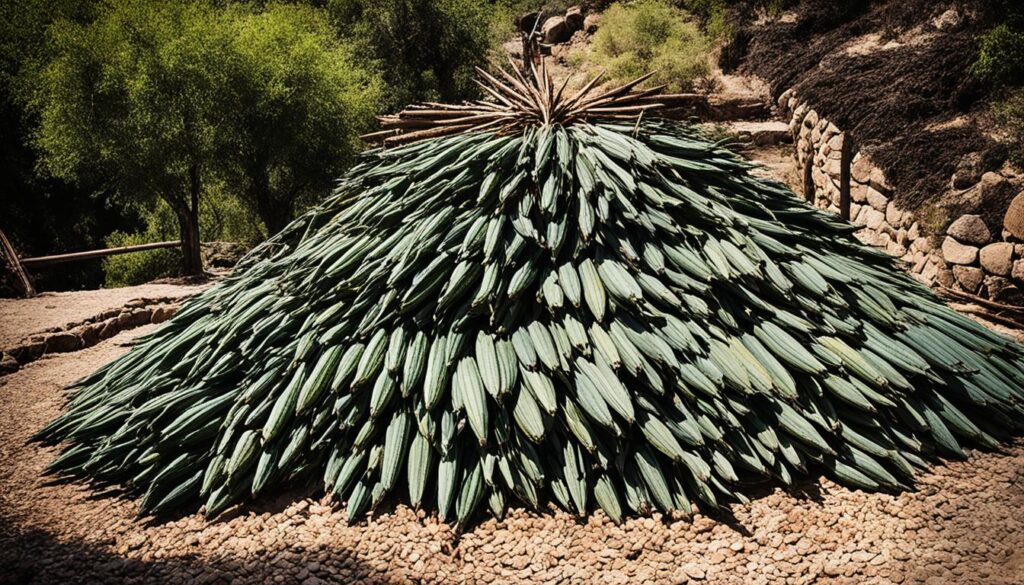
Mezcal’s regional diversity and utilization of different agave species create a captivating world of flavors and aromas. It is a spirit that invites exploration and appreciation for the artistry involved in its production. From the mezcal-rich lands of Oaxaca to the skilled hands of the mezcaleros, each sip of mezcal reveals a story, a place, and a vibrant culture.
The Harvesting Process of Agave
When it comes to agave harvesting, the skilled hands of jimadores play a crucial role. These experienced agave farmers carefully remove the leaves, revealing the prized piña or heart of the agave plant. This manual process requires precision, as the jimadores must extract the piña intact, ensuring optimal flavor and quality.
The piñas, resembling massive pineapples, are then transported to the distillery for further processing. It is in these piñas that the natural sugars are concentrated, providing the foundation for the rich flavors found in agave spirits like tequila and mezcal.
A key aspect of agave harvesting is determining the ideal time for harvest. The maturity of the plants can vary depending on the agave species and the desired flavor profile. Some agave varieties, such as the Blue Weber, can take up to 7-14 years to reach maturity, while others may require even longer, up to 20-40 years.
Agave harvesting is an art form that combines traditional knowledge, patience, and respect for the land. It is a testament to the dedication and craftsmanship that goes into every bottle of tequila or mezcal.
The Agave Harvesting Process:
- Jimadores carefully remove the leaves to reveal the piña, the heart of the agave plant.
- The piñas are transported to the distillery for further processing.
- The maturity of the plants is crucial in determining the optimal time for harvest.
In the words of a seasoned jimador:
“Agave harvesting is more than just a job; it is a connection to the land and a way of preserving our heritage. We honor the agave plants by harvesting them with care and ensuring that their essence lives on in every sip.”
To visualize the agave harvesting process, take a look at the image below:
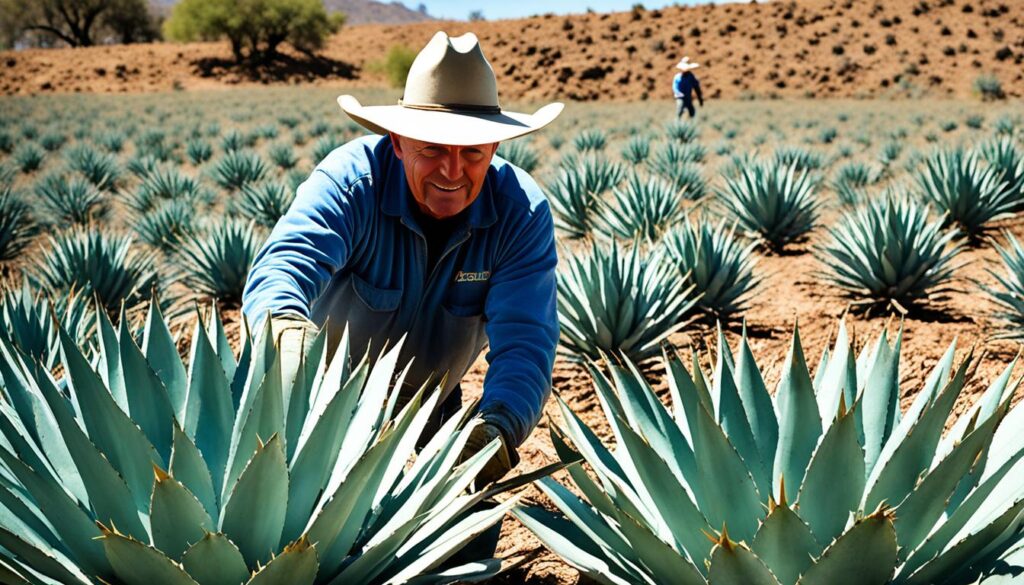
| Agave Harvesting Process | Benefits |
|---|---|
| Precise removal of leaves to extract the piña | Preserves the optimal flavor and quality of agave spirits |
| Meticulous transportation of piñas to the distillery | Ensures the integrity and freshness of the harvested agave |
| Timing the harvest based on agave maturity | Enhances the flavors and characteristics of the final product |
The Cooking Process in Agave Spirit Production
The cooking process is a significant difference between tequila and mezcal production. Tequila is typically cooked in traditional ovens called hornos for several days, while mezcal is slow-roasted in stone-lined pits in the ground, often for several days as well.
Traditional ovens, or hornos, are essential in the tequila cooking process, where the agave piñas are slowly steamed to convert the starches into fermentable sugars. The piñas are stacked inside the oven and covered with layers of agave fiber to seal in the heat and moisture, creating a controlled cooking environment.
Tequila producers who utilize traditional ovens believe that this slow and gradual cooking process allows for enhanced flavor development and a smoother spirit. The time-consuming nature of using hornos can be seen as a testament to the dedication and craftsmanship of tequila production.
In contrast, mezcal production involves the use of stone-lined pits in the ground for cooking the agave. The piñas are stacked inside the pits, which are then covered with earth and agave fibers before being set on fire. The slow-roasting process can last several days, allowing the smoky flavors characteristic of mezcal to develop.
I was enthralled by the sight of the traditional ovens in the tequila distilleries. The aroma of slowly cooked agave permeated the air, signaling the transformation taking place within the ovens.
While traditional ovens and stone-lined pits are the conventional methods of cooking agave, modern tequila production has also incorporated the use of autoclaves. Autoclaves are large, stainless steel pressure cookers that can significantly reduce cooking time. This efficiency allows for faster extraction of sugars from the agave, resulting in an increased production capacity.
Despite the convenience offered by autoclaves, some tequila connoisseurs argue that this modern approach sacrifices the depth and complexity of flavors that can be achieved through the traditional cooking process.
Ultimately, whether using traditional ovens, stone-lined pits, or autoclaves, the cooking process plays a crucial role in shaping the distinctive characteristics of tequila and mezcal.
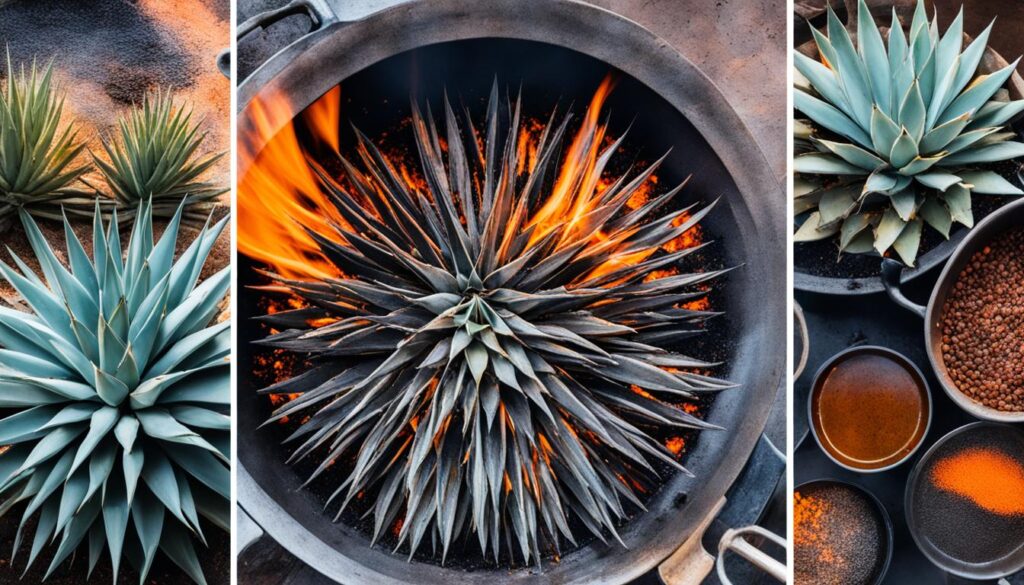
The Agave Cooking Process: A Comparison
| Agave Spirit | Cooking Method | Cooking Duration | Resulting Flavor |
|---|---|---|---|
| Tequila | Traditional ovens (hornos) or autoclaves | Several days for traditional ovens Decreased time for autoclaves |
Complex and nuanced flavors for traditional ovens Efficiency and consistency for autoclaves |
| Mezcal | Stone-lined pits | Several days | Rich, smoky flavors |
Crushing and Extracting Agave Juice
Once the agave is cooked to perfection, the next step is to crush it to extract the precious juice. This delicate process is similar to the method used for crushing grapes during wine production. By extracting the juice from the agave, we unlock the flavors and sugars necessary for the fermentation stage of creating agave spirits.
The crushing process involves separating the juice, known as aguamiel, from the fibers or pulp of the agave plant. This extraction is crucial in capturing the essence of the agave and achieving the desired taste profile for the final product.
“The careful extraction of agave juice is a pivotal step in creating exceptional agave spirits. It is through this process that we capture the true essence of the agave plant, revealing its unique flavors and aromas.”
Once the juice is extracted, it is collected and prepared for fermentation. This meticulously crafted process ensures that every drop of agave juice is used to its fullest potential, resulting in the distinctive qualities that make agave spirits so revered.
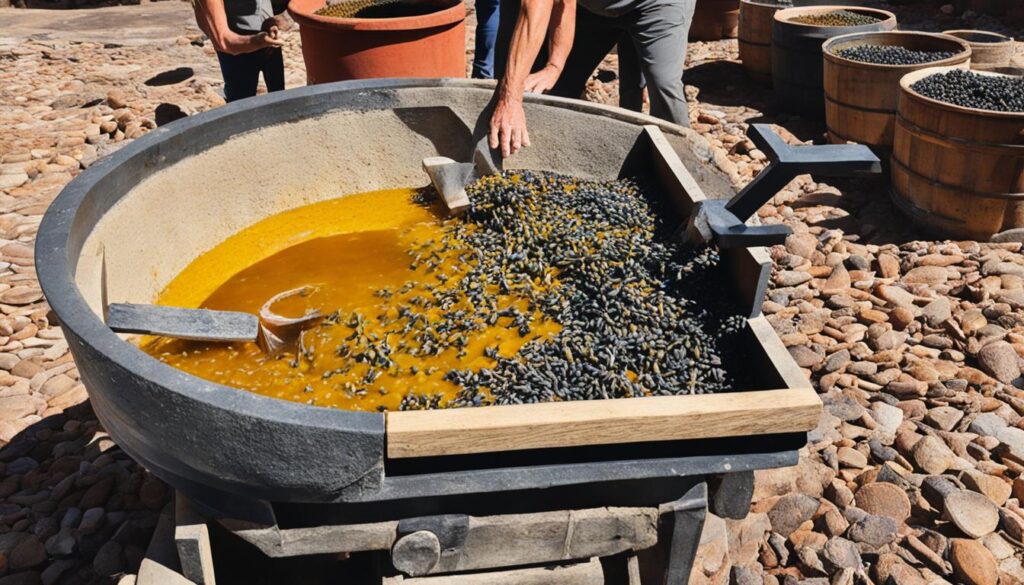
The Agave Crushing Process Explained
The agave crushing process involves different techniques and tools, depending on the traditional practices used by each distillery. Some common methods include:
- Stone Tahona: This traditional method employs a large stone wheel called a tahona, which is manually rolled over the cooked agave to crush it and extract the juice.
- Manual Crushing: In this approach, a group of skilled workers, known as jimadores, use specialized tools to break down the agave piñas and extract the juice.
- Mechanical Crushers: More modern distilleries may use mechanized crushers to extract the juice efficiently. These machines are designed to mimic the crushing action performed by traditional methods.
The choice of crushing method can have an impact on the overall flavor profile of the agave spirits. Traditional methods, such as the stone tahona, are often favored for their ability to extract the juice while preserving the unique characteristics of the agave plant.
| Crushing Method | Flavor Profile |
|---|---|
| Stone Tahona | Well-rounded and earthy |
| Manual Crushing | Artisanal and complex |
| Mechanical Crushers | Consistent and efficient |
Each crushing method brings its own unique element to the agave crushing process, contributing to the diverse range of flavors found in agave spirits.
Fermentation and Distillation of Agave Spirits
Once the agave juice, known as aguamiel, is extracted, it undergoes the crucial fermentation and distillation processes that contribute to the unique characteristics and flavors of agave spirits.
In the fermentation process, the sugars present in the aguamiel are converted into alcohol by the action of yeast. This transformation occurs through the natural process of fermentation, where the yeast consumes the sugars, releasing alcohol and carbon dioxide as byproducts.
The agave fermentation process is a key step in agave spirit production, as it helps develop the distinct flavors and aromas associated with tequila and mezcal.
When it comes to tequila production, commercial yeasts are typically used to initiate the fermentation process. These specially selected yeasts ensure consistency and control over the final product. The fermentation takes place in large stainless steel tanks, allowing for a controlled environment that promotes yeast activity.
On the other hand, traditional mezcal producers rely on wild yeasts present in the environment to naturally ferment the aguamiel. This traditional method adds complexity and unique flavor profiles to the mezcal.
Following fermentation, the next step is distillation. Distillation is the process of separating alcohol from the fermented liquid through heating and condensation. The purpose of distillation is to concentrate and purify the alcohol, ensuring a smooth and well-balanced agave spirit.
The agave distillation process contributes to the refinement of the final product, creating a spirit with distinctive character and quality.
In tequila production, column stills are commonly used for distillation. These tall, continuous stills allow for efficient separation of alcohol from impurities, producing a clean and crisp tequila.
On the other hand, mezcal is often distilled in small batch pot stills. These traditional copper or clay stills capture the essence of the agave, resulting in a mezcal with a rich and robust flavor profile.
While the distillation methods vary, both tequila and mezcal require careful attention to detail and skillful craftsmanship to create exceptional agave spirits.
Tequila Distillation Process
| Tequila Distillation Process | Key Characteristics |
|---|---|
| Column Stills | Efficient separation of alcohol and impurities |
| Controlled environment | Consistency in flavor and quality |
Mezcal Distillation Process
| Mezcal Distillation Process | Key Characteristics |
|---|---|
| Pot Stills | Capture the essence of the agave |
| Traditional method | Unique and complex flavor profiles |
Aging Agave Spirits: From Blanco to Extra Añejo
Aging is a crucial step in the production of tequila, adding complexity and depth to the final product. While aging is optional, many tequila producers take advantage of this process to create a range of flavor profiles.
Tequila Aging Process:
Tequila is aged in oak barrels, allowing the spirit to interact with the wood and develop unique characteristics over time. The aging process softens the agave flavors and imparts notes of vanilla, caramel, and spice.
- Blanco/Plata/Silver: This is the youngest tequila, bottled immediately after distillation. It is clear and showcases the purest expression of agave flavors.
- Reposado: Reposado tequila is aged in oak barrels for a minimum of two months, but less than a year. This aging period lends the tequila a smoothness and subtle complexity.
- Añejo: Añejo tequila is aged in oak barrels for a minimum of one year, but less than three years. The extended aging time results in a deeper, richer flavor profile with more pronounced notes of oak.
- Extra Añejo: This is the most aged and premium category of tequila. Extra Añejo tequila is aged in oak barrels for a minimum of three years, allowing for the development of luxurious, complex flavors and aromas.
Mezcal Aging:
Unlike tequila, mezcal doesn’t have formal aging categories. However, some mezcal producers choose to age their spirits in oak barrels to enhance the flavor and complexity. The aging period varies depending on the producer and desired outcome. Oak aging adds a touch of smokiness and additional layers of flavor to the mezcal.
The Influence of Aging on Tequila Flavor Profiles
Aging in oak barrels affects the flavor profile of tequila, transforming it into a more refined and nuanced spirit. Let’s take a closer look at the different aging categories and the distinct characteristics they offer:
| Tequila Aging Category | Description | Flavor Profile |
|---|---|---|
| Blanco/Plata/Silver | Bottled immediately after distillation, without any aging. | Clean, vibrant, and full of agave flavors with slight peppery notes. |
| Reposado | Aged in oak barrels for a minimum of two months, but less than a year. | Smooth, balanced, with hints of vanilla, caramel, and oak. |
| Añejo | Aged in oak barrels for a minimum of one year, but less than three years. | Rich, complex, with pronounced oak influence and notes of chocolate, dried fruit, and spices. |
| Extra Añejo | The most aged tequila, aged in oak barrels for a minimum of three years. | Luxurious, velvety, with deep flavors of oak, caramel, and tobacco. |
The Global Icon: Tequila’s Rise to Fame
Tequila has transcended its Mexican origins to become a global phenomenon, captivating the palates of spirits enthusiasts around the world. With a rich history rooted in tradition and craftsmanship, tequila has evolved into a cultural symbol that embodies the spirit of Mexico.
From its humble beginnings in the Jalisco region of Mexico, tequila has seen a remarkable journey of growth and popularity. Its roots can be traced back to the 16th century, when Spanish conquistadors brought the art of distillation to the New World. Over time, tequila became deeply intertwined with Mexican culture, celebrating its vibrant flavors and heritage.
Today, tequila is enjoyed on every continent, revered for its distinct taste and versatility. It has become a staple in bars and households worldwide, adorning shelves with an impressive array of brands and expressions. From classic margaritas to sophisticated sipping tequilas, there is something for every discerning palate.
“Tequila is more than just a drink; it is a cultural symbol that represents the warmth, passion, and zest for life that is characteristic of Mexico.”
Tequila’s global popularity has sparked a surge in interest and innovation within the industry. New branding and marketing strategies have elevated tequila to new heights, appealing to a diverse range of consumers. Mixologists and bartenders continue to explore the boundaries of tequila, experimenting with unique cocktails and flavor combinations.
The Blue Weber agave, the cornerstone of tequila production, remains an integral part of its success. This resilient succulent continues to thrive in the volcanic-rich soils of Mexico, yielding the sweet and robust flavor profile that sets tequila apart. The meticulous cultivation, harvesting, and distillation processes ensure the preservation of tequila’s unique character.
| Tequila’s Global Popularity | Tequila as a Cultural Symbol |
|---|---|
|
|
The Future of Agave and Tequila Production
The increasing demand for tequila has raised concerns about agave sustainability and the challenges faced by tequila production. As the popularity of this beloved Mexican spirit continues to grow, it is crucial to address these issues to ensure a long-lasting and sustainable industry.
Efforts are being made to promote sustainable agave farming practices that prioritize the preservation of agave species and the environment. This includes responsible water usage, soil conservation, and the use of organic fertilizers. By adopting these practices, tequila producers can mitigate the environmental impact of agave cultivation and contribute to the long-term health and biodiversity of agave plants.
Furthermore, there is a shift towards artisanal and small-batch tequilas that prioritize quality and sustainability over mass production. These tequilas are often crafted using traditional methods, hand-harvested agave, and a focus on terroir to create unique flavor profiles. By supporting these smaller producers, consumers can contribute to the preservation of agave diversity and the preservation of traditional tequila-making practices.
“The future of tequila production lies in our commitment to agave sustainability and responsible farming practices. By prioritizing the health of our agave plants and embracing artisanal production methods, we can ensure that future generations will continue to enjoy the exceptional flavors and cultural significance of tequila.”
Sustainable Practices in Agave Farming
Tequila producers are implementing sustainable practices to mitigate the challenges posed by agave farming. These practices include:
- Conserving water through efficient irrigation techniques
- Protecting soil health and preventing erosion
- Minimizing chemical usage and embracing organic farming methods
- Promoting biodiversity and preserving native agave species
- Supporting local communities and fair labor practices
By adopting these sustainable practices, tequila producers can ensure the future availability of agave and protect the natural resources necessary for tequila production.
The Role of Consumer Choice
Consumers play a vital role in shaping the future of agave and tequila production. By making conscious purchasing decisions, they can support tequila brands that prioritize sustainability and responsible farming practices. This includes choosing tequilas made from agave grown under sustainable conditions and supporting brands that actively contribute to agave conservation efforts.
Additionally, educating oneself about the origins and production practices of tequila can empower consumers to make informed choices and support producers who are committed to environmental and social sustainability. Through their purchasing power, consumers can be catalysts for positive change in the tequila industry.
Achieving a Sustainable Future
The future of agave and tequila production relies on a collective commitment to sustainability. By implementing sustainable farming practices, supporting small-batch and artisanal tequila producers, and making conscious consumer choices, we can ensure the preservation of agave species, protect the environment, and continue to enjoy the rich cultural heritage of tequila for generations to come.
Appreciating the Ancient Roots and Mythology of Tequila
Tequila is more than just a beloved Mexican spirit – it carries with it a rich history rooted in ancient Mexican culture and mythology. From the sacred agave plant prized by the Aztecs to the international recognition of tequila as a cultural icon, its origins are steeped in mystique and tradition.
The agave plant, with its long, spiky leaves and succulent core, was revered by the Aztecs as a gift from the gods. They believed it held divine properties and used it for rituals and ceremonies. The agave plant was so sacred that they even named it “mexcalli,” meaning “cooked agave,” which eventually gave rise to the term “mezcal.”
Over time, the knowledge and techniques of agave cultivation and tequila production were passed down through generations, preserving the ancient roots of this iconic Mexican spirit. Today, tequila is celebrated not only for its unique flavor profiles but also for its cultural significance and the craftsmanship involved in its production.
Exploring the mythology and ancient traditions associated with tequila can deepen our appreciation for this time-honored spirit. It allows us to connect with the history and traditions of Mexico and understand the deep cultural significance that tequila holds. So next time you raise a glass of tequila, take a moment to reflect on the ancient roots and mythology that contribute to its allure.